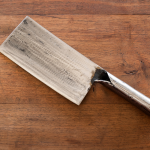The Sujihiki knife, a significant member of the Japanese culinary toolkit, is known for its slender and long blade which excels in slicing through meat and fish with precision. Like other high-quality knives, a Sujihiki requires a certain level of care and maintenance to retain its performance and prolong its lifespan. Here’s a comprehensive guide on how to correctly care for your Sujihiki knife:
Proper Cleaning:
After each use, clean your Sujihiki knife by hand with warm water and mild detergent. Avoid using a dishwasher as it can damage the delicate blade.
Dry the knife immediately with a soft cloth to prevent water spots and rusting.
It’s advisable to clean the knife as soon as possible after use to prevent any residue from drying on the blade.
Sharpening:
Regular sharpening is crucial to maintain the sharp edge of your Sujihiki knife.
Use a high-grit whetstone for sharpening. Begin with a coarser grit to remove any nicks and then move to a finer grit for a razor-sharp edge.
Maintain a consistent angle while sharpening, typically around 15 degrees for Japanese knives.
It’s advisable to seek professional sharpening if you are unfamiliar with the process, as incorrect sharpening can damage the blade.
Storage:
Store your Sujihiki knife in a wooden block, magnetic knife strip, or a protective sheath to prevent the blade from becoming nicked or dulled.
Avoid tossing it in a drawer with other utensils as it may get damaged.
Usage:
Use a proper cutting board made from softwood or plastic to ensure the longevity of the blade.
Avoid cutting on hard surfaces such as glass, stone, or metal which can dull or damage the blade.
The Sujihiki knife is designed for slicing rather than chopping, so use it for its intended purpose to maintain its edge and integrity.
Regular Inspection:
Inspect your knife regularly for signs of wear or damage.
If you notice any rust spots, remove them promptly using a rust eraser or a mixture of baking soda and water.
Oil Treatment:
If your Sujihiki knife has a carbon steel blade, it’s beneficial to apply a light coat of oil after cleaning to prevent rust.
The elegance of a Sujihiki knife is matched by its precision and efficiency in the kitchen. With correct maintenance, your Sujihiki knife can remain an invaluable asset in your culinary endeavors for many years. Adhering to the guidelines outlined above will ensure that your knife continues to perform at its best, embodying the exquisite fusion of Japanese tradition and functionality.







